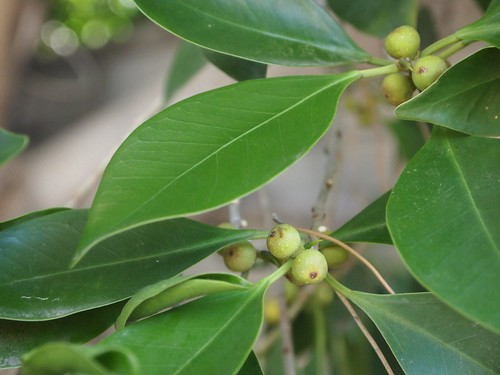Garden Inventory is a series where I begin an inventory of all the plants and trees in my garden. Along with some of my own pictures, I will link to various sources of information about each plant and tree so we can learn a little more together.
I would also like to highlight your special plants and tress. Pass along your favorite plants in the comments and I will use them for future Garden Inventory posts. — Douglas
Garden Inventory: Ficus benjamina
“Ficus benjamina, commonly known as the weeping fig, Benjamin’s fig, or ficus tree and often sold in stores as just ficus, is a species of flowering plant in the family Moraceae, native to south and southeast Asia and Australia. It is the official tree of Bangkok. It is a tree reaching 30 metres (98 ft) tall in natural conditions, with gracefully drooping branchlets and glossy leaves 6–13 cm (2–5 in), oval with an acuminate tip. In its native range, its small fruit are favored by some birds, such as the Superb Fruit Dove, Wompoo Fruit Dove, Pink-spotted Fruit Dove, Ornate Fruit Dove, orange-bellied Fruit Dove, Torresian Imperial Pigeon, Purple-tailed Imperial Pigeon (Frith et al. 1976).” — http://en.wikipedia.org/wiki/Ficus_benjamina
Most people are familiar with Ficus as the ubiquitous houseplant and small tree that graces office buildings around the globe. Here in Los Angeles, though, they were also used a street trees for a number of years, but recently that decision has “come home to roost” in the form of destroyed sidewalks, curbs and streets. Ficus roots are quite strong and aggressive and will readily turn over any construction put in their path. You need to choose their location quite well to insure you aren’t regretting your decision to plant them down the road.
I have 3 large ficus in my garden and, to be honest, I have never really liked them that much. Their foliage is very dense and creates some spots of deep shade under their canopy. This canopy can be quite beneficial in the host summer months here in the San Fernando Valley. Ficus also drop quite a load of leaves, although being evergreen, they never drop all their leaves at once.
On the plus side, they don’t need much pruning and, except for a small amount of frost damage on occasion, they don’t seem to have any issues with disease or pests. They do provide a small green fruit, although I have never noticed any of my birds or wildlife eating them. You can see these fruits in the some of the pictures below.
Photos of Ficus benjamina closeups of leaves, fruit, growing habit, trunk and bark
More information on Ficus Bejamina:
- Ficus benjamina at Wikipedia
- Ficus benjamina at Dave’s Garden
- Skin irritation from Ficus bejamina at North Carolina Sate University
- Ficus benjamina from the University of Vermont
Previously on Garden Inventory:









